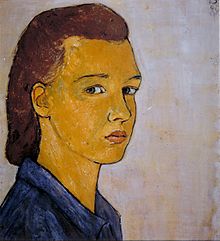
by HANNAH ARNAUD
Murdered 10 October 1943 at the age of 26.
Charlotte Salomon, born in 1917 Berlin to a Jewish family, is best known for Leben? Oder Theater?: Ein Singspiel (Life? Or Theatre?: A Song-Play). An early example of the graphic novel form, it is a series of images accompanied by text and music cues that tells a semi-fictionalised account of Salomon’s life.
When Salomon was nine, her mother committed suicide. Charlotte was told that she had died from influenza. It wasn’t until 1938, when Salomon had been sent from Nazi Germany to live with her grandparents in the South of France, that her grandfather told her the truth. She was also told about multiple other female members of the family who had killed themselves.
When France signed the Armistice with Nazi Germany in 1940, Salomon and her grandfather were sent by the French authorities to a camp in the Pyrenees. Her diaries from this time suggest that he sexually abused her. When they were released Salomon rented a room and began to paint, producing a thousand individual gouches over the course of two years. These formed the basis of Leben? Oder Theater?: Ein Singspiel. The story of her grandfather’s abuse lies behind her confession of poisoning him as revealed in a recently found letter. Read more about this in Toni Bentley’s article in The New Yorker, https://www.newyorker.com/culture/culture-desk/the-obsessive-art-and-great-confession-of-charlotte-salomon). A few months later Salomon married Alexander Nagler, another German Jewish refugee. In October 1943 they were deported from their home in Nice to Auschwitz where they were murdered.
Salomon’s death in the Holocaust has been used as a prism through which to interpret her art. When London’s Jewish Museum curated an exhibition of her gouaches in 2019, Jonathan Jones reviewed it for The Guardian in an article calling her ‘A spirit the Nazis couldn’t erase’.’An article in the Smithsonian Magazine from the same year has the headline ‘The Genre-Bending, Death-Defying Triumph of Charlotte Salomon’s Art’. These headlines suggest that Salomon’s art is somehow a victory in the face of Nazi extermination.
Both critics ensure that Salomon’s genius is interpreted through the prism of her being a Holocaust victim. In doing so they take part in a broader cultural trend to box in and sanitize the lives of Jews murdered by the Nazis. This is reductive. Their lives are told as neat narratives in which saint-like figures demonstrate ‘spirit’ and ‘triumph’ over the Nazi death- machine. Salomon follows Anne Frank in this sanctifying of the young Jewish woman.
While Leben? Oder Theater? contains occasional scenes which reference the increasing restrictions on Jewish life after the rise of Hitler, it is not about the later Holocaust and Charlotte Salomon was certainly not a saint. She was messy and complicated and her work is much more than a record of her tragic murder. Tellingly, in Leben? Oder Theater? Salomon chose to name the character which represents her ‘Charlotte Kann’. ‘Kann’ means ‘can’ so her name is a rallying call for female action. It is time for us to recognise her complexity as a major Jewish artist and challenge the accepted narrative of Salomon as a victim. The easy destruction of women by violent males in our society is finally, if frustratingly slowly, becoming part of public discourse. Salomon was abused as a Jewish woman in Germany and France. She was murdered by those whose aim was to eradicate Jews. As a critic of personal and political violence, her life and artwork won’t provide easy answers, but her artistic legacy can push us to start asking the right questions.
To find out more about Charlotte Salomon visit these websites:
- https://www.newyorker.com/culture/culture-desk/the-obsessive-art-and-great-confession-of-charlotte-salomon
- https://jck.nl/en/page/charlotte-salomon-work
Hannah Arnaud has just spent a year working for Noam, a Jewish youth movement. She is about to start a Masters degree in Shakespeare Studies at the same time as teaching at her local synagogue. She is delighted to be working with the Pascal Theatre Company, bringing together her love of both Judaism and drama.

